Where to Find Comet PanSTARRS
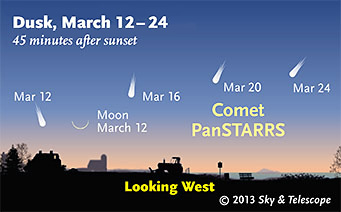
Bring binoculars to pick the comet out of the twilight low in the west. Don't expect it to look this obvious!.
You're welcome to reprint this illustration anywhere, but include a credit to Sky & Telescope magazine and a link to SkyandTelescope.com. Click here for the high-res version.
Sky & Telescope diagram
Comet PanSTARRS, for all the attention it has received, is barely visible to the unaided eye and only if you know exactly where to look. That's low in twilight, just a little to the right of due west, about 45 minutes after sunset. The comet is now fading even as it gains a bit more altitude as seen from the world's mid-northern latitudes. Bring binoculars or, better, a low-power, wide-field telescope.
This illustration is drawn for skywatchers at latitude 40° N (Denver, New York, Madrid). See our continuing updates at SkyandTelescope.com/panstarrs. Recent pictures.
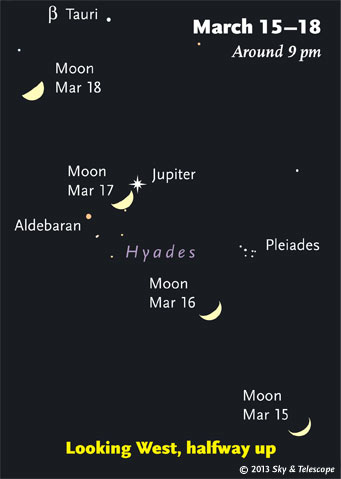
Watch the Moon wax to, and through, the evening Jupiter group. (Drawn for the middle of North America. European observers: move each Moon symbol a quarter of the way toward the one for the previous date. The Moon is shown three times its actual size.)
Friday, March 15
Saturday, March 16
Sunday, March 17
Monday, March 18
Tuesday, March 19
Wednesday, March 20
Thursday, March 21
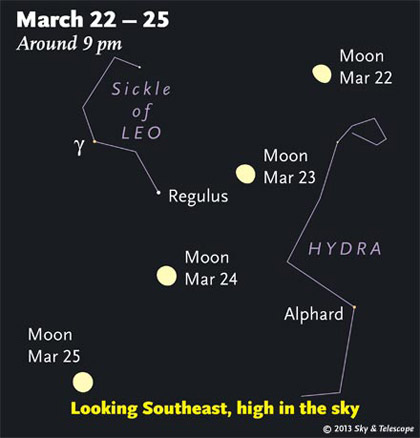
As the Moon waxes toward full, it walks between Leo and mostly-dim Hydra.
Sky & Telescope diagram
Friday, March 22
Saturday, March 23
Want to become a better amateur astronomer? Learn your way around the constellations. They're the key to locating everything fainter and deeper to hunt with binoculars or a telescope.
For an easy-to-use constellation guide covering the whole evening sky, use the big monthly map in the center of each issue of Sky & Telescope, the essential guide to astronomy. Or download our free Getting Started in Astronomy booklet (which only has bimonthly maps).

The Pocket Sky Atlas plots 30,796 stars to magnitude 7.6 — which may sound like a lot, but that's less than one star in an entire telescopic field of view, on average. By comparison, Sky Atlas 2000.0 plots 81,312 stars to magnitude 8.5, typically one or two stars per telescopic field. Both atlases include many hundreds of deep-sky targets — galaxies, star clusters, and nebulae — to hunt among the stars.
Sky & Telescope
Once you get a telescope, to put it to good use you'll need a detailed, large-scale sky atlas (set of charts). The standards are the little Pocket Sky Atlas, which shows stars to magnitude 7.6; the larger and deeper Sky Atlas 2000.0 (stars to magnitude 8.5); and the even larger Uranometria 2000.0 (stars to magnitude 9.75). And read how to use sky charts with a telescope effectively.
You'll also want a good deep-sky guidebook, such as Sue French's Deep-Sky Wonders collection (which includes its own charts), Sky Atlas 2000.0 Companion by Strong and Sinnott, the bigger Night Sky Observer's Guide by Kepple and Sanner, or the beloved if dated Burnham's Celestial Handbook.
Can a computerized telescope replace charts? Not for beginners, I don't think, and certainly not on mounts and tripods that are less than top-quality mechanically (able to point with better than 0.2° repeatability). As Terence Dickinson and Alan Dyer say in their invaluable Backyard Astronomer's Guide, "A full appreciation of the universe cannot come without developing the skills to find things in the sky and understanding how the sky works. This knowledge comes only by spending time under the stars with star maps in hand."
This Week's Planet Roundup
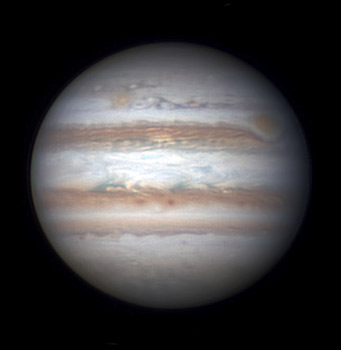
As Jupiter shrinks into the distance, its most striking characteristic in amateur telescopes is the single, broad South Equatorial Belt (above center) contrasting with the paired North Equatorial and North Temperate Belts. South here is up. Note the Great Red Spot at right, in a well-defined white Red Spot Hollow. Compare it to smaller, paler orange Oval BA left of the central meridian. Blue festoons mark the north edge of the bright Equatorial Zone.
Mercury is still far down in the glow of dawn, and it's only brightening from magnitude +1.5 to +0.5 this week. Don't bother.
Venus and Mars are hidden in the glare of the Sun.
Jupiter (magnitude –2.2, in Taurus) comes into view high in the southwest after sunset and dominates the western sky later in the evening. Lower left of Jupiter is orange Aldebaran. Farther to Jupiter's lower right are the Pleiades. They all set in the west-northwest around the middle of the night.
Jupiter is not as bright as it was a few weeks ago, and in a telescope it has shrunk to 37 arcseconds wide.
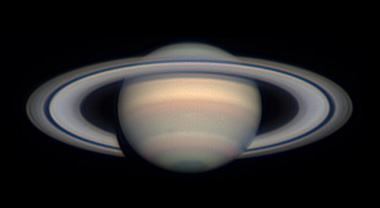
Saturn on March 2, 2013, imaged by Christopher Go. South is up. Note the bright Equatorial Zone and, tougher to see, the thin whitish band at mid-northern latitudes: the last remnant of the great white storm that broke out at this latitude in December 2010.
Saturn (magnitude +0.3, in Libra) rises in the east-southeast around 11 p.m. daylight saving time. Watch for it rising well to the lower left of Spica and farther to the lower right of brighter Arcturus. Saturn shines highest in the south in the early morning hours — more or less between Spica to its right and Antares farther to its lower left.
Saturn will come to opposition on the night of April 27th. In a telescope, Saturn's rings are now tilted a wide 19° from our line of sight.
Uranus and Neptune are lost in the glare of the Sun.
All descriptions that relate to your horizon — including the words up, down, right, and left — are written for the world's mid-northern latitudes. Descriptions that also depend on longitude (mainly Moon positions) are for North America. Eastern Daylight Time (EDT) equals Universal Time (also known as UT, UTC, or GMT) minus 4 hours.
Like This Week's Sky at a Glance? Watch our SkyWeek TV short. It's also playing on PBS!
To be sure to get the current Sky at a Glance, bookmark this URL:
http://SkyandTelescope.com/observing/ataglance?1=1
If pictures fail to load, refresh the page. If they still fail to load, change the 1 at the end of the URL to any other character and try again.
 0
0
Comments
You must be logged in to post a comment.